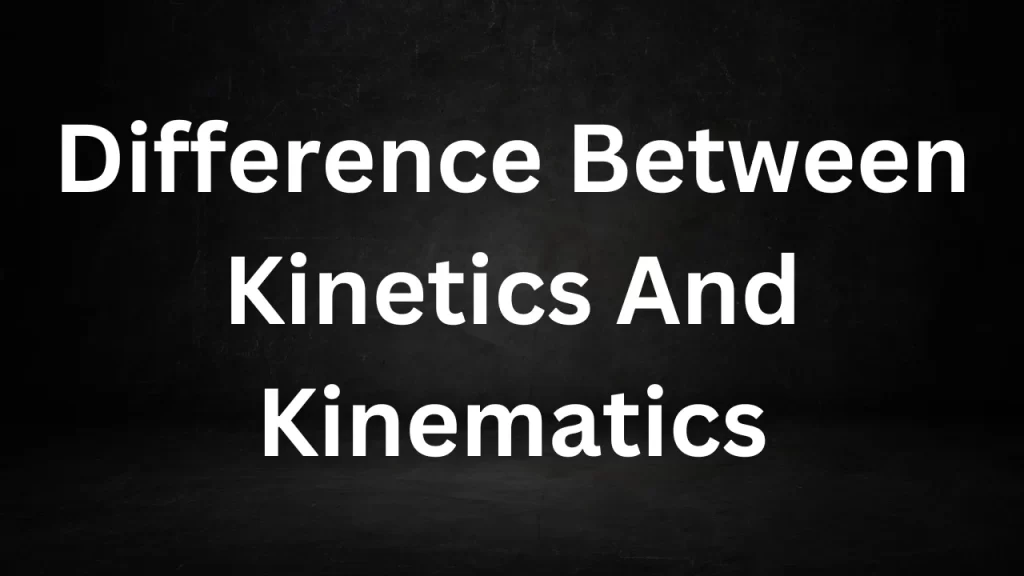Difference Between Kinetics And Kinematics
Difference Between Kinetics And Kinematics: Kinetics and kinematics are both subfields of physics that encompass the study of an object’s motion. While these terms may appear similar, they do exhibit distinct differences.

Difference Between Kinetics And Kinematics
Nature of Study:
Kinematics: Kinematics is the branch of physics that deals with the study of motion of objects without considering the forces causing that motion. It focuses on describing the position, velocity, and acceleration of objects as they move through space and time.
Kinetics: Kinetics, on the other hand, is the branch of physics that delves into the causes of motion. It is concerned with the analysis of the forces, torques, and energy transfers that lead to changes in an object’s motion.
Fundamental Concepts:
Kinematics: Kinematics primarily deals with concepts like displacement, velocity, acceleration, and time. It provides a framework for describing how objects move and change position relative to time.
Kinetics: Kinetics is centered on concepts like force, mass, inertia, work, energy, and momentum. It investigates how these factors interact to produce or change motion.
Representation:
Kinematics: Kinematics is often represented mathematically through equations and graphs that describe an object’s motion in terms of position, velocity, and acceleration as functions of time.
Kinetics: Kinetics involves the use of Newton’s laws of motion, equations of motion, and various mathematical principles to analyze and predict the forces acting on objects and their resulting motion.
Key Questions:
Kinematics: Kinematics answers questions like “What is the object’s position at a given time?” or “How fast is the object moving?” It focuses on the “what” and “how” of motion.
Kinetics: Kinetics addresses questions like “Why is the object accelerating?” or “What force is causing the object to move?” It investigates the underlying causes and the “why” of motion.
Example:
Kinematics: When describing the motion of a car on a highway, kinematics would provide information about the car’s speed, its change in position over time, and how its velocity is changing.
Kinetics: Kinetics, in the context of the same car, would analyze the forces acting on it, such as engine force, friction, and air resistance, to explain why the car is accelerating, decelerating, or maintaining a constant speed.
In summary, kinematics is concerned with describing the motion of objects and their geometric characteristics (position, velocity, acceleration) without considering the underlying forces.
Kinetics, on the other hand, focuses on understanding the forces and interactions that cause objects to move or change their state of motion. Both branches are essential in the study of mechanics and the analysis of physical systems.
Read More
- Changing States Of Matter Class 9
- Average Speed And Average Velocity Class 9
- Differences Between Acceleration And Velocity
- Matter In Our Surroundings Class 9 Summary
- Class 9th Chapter 2 Science Question Answer of NCERT
Frequently Asked Question (FAQs)
What is the primary focus of kinematics?
Kinematics primarily focuses on describing the motion of objects, including parameters such as position, velocity, acceleration, and time, without considering the forces causing that motion.
How does kinetics differ from kinematics in terms of focus?
Kinetics is concerned with understanding the causes of motion, particularly the forces, torques, and energy transfers that lead to changes in an object’s motion.
Can you provide an example illustrating the difference between kinetics and kinematics?
Certainly. Consider a car moving along a road. Kinematics would describe its speed, position changes, and acceleration patterns. Kinetics, on the other hand, would analyze the forces responsible for the car’s motion, such as engine force, friction, and air resistance.
What are some fundamental concepts in kinematics?
In kinematics, fundamental concepts include displacement, velocity, acceleration, and time. These concepts help describe how objects move without delving into the causes of motion.
What key concepts are involved in kinetics?
Kinetics involves concepts like force, mass, inertia, work, energy, and momentum. It investigates how these factors interact to produce or change motion and explores the underlying causes of motion.